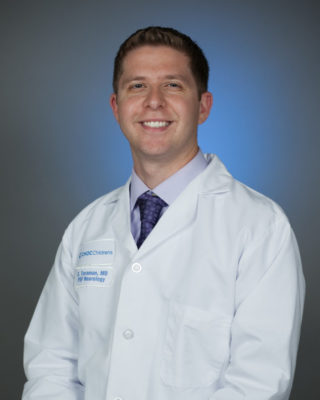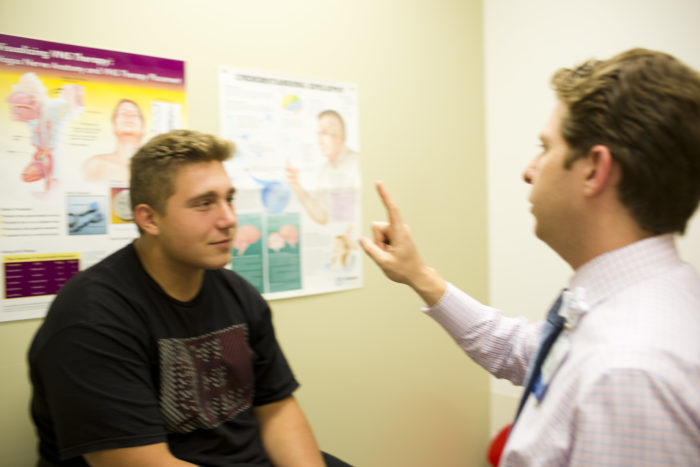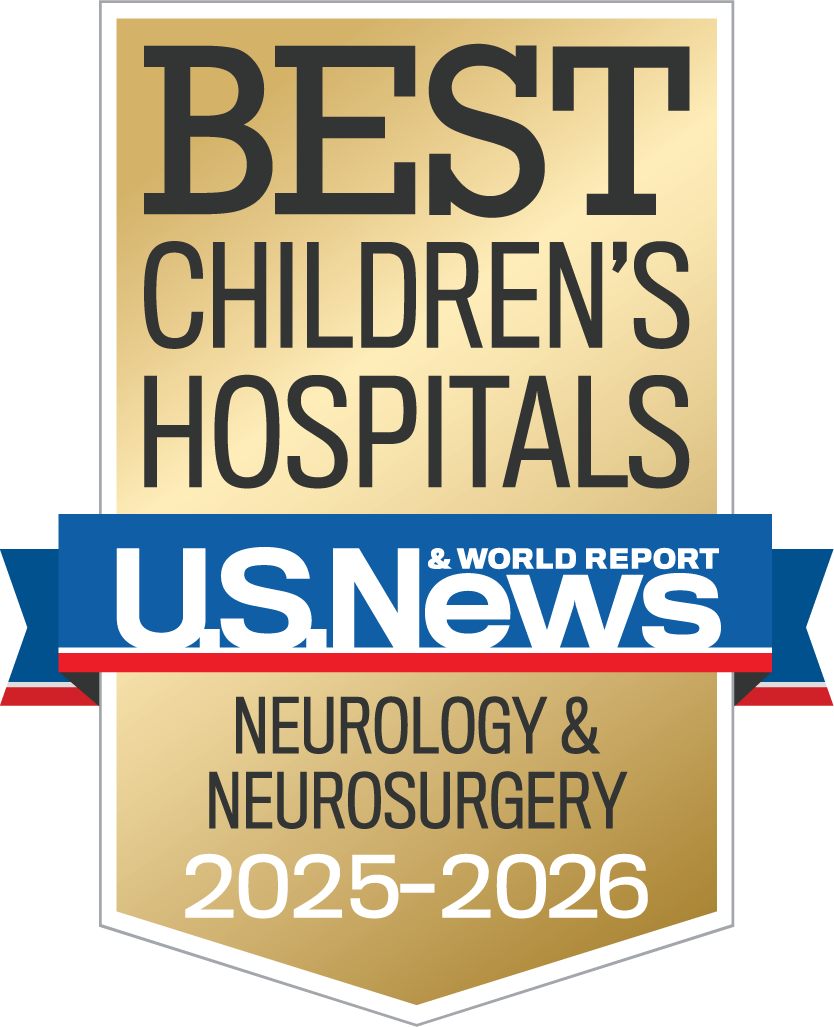When child and adolescent patients complain to their parents about a headache, it can be anything from a plea to stay home from school in hopes of avoiding a test, to a sign of something more serious.
Dr. Sharief Taraman, a pediatric neurologist at CHOC, offers advice to the referring community on acute and chronic headache management in children and teens, including headache hygiene, non-medical intervention options, and referral guidelines.

Types of headaches often seen in children and adolescents
Migraine symptoms in kids
- At least 5 attacks that meet the following criteria:
- Headache lasting 1 – 72 hours
- Headache has at least two of the following features:
- Pain on both side or one side of the head
- Pain is pulsating
- Moderate to severe intensity
- Aggravated by routine physical activities
- At least one of the following:
- Nausea and/or vomiting
- Sensitivity to light or noise
- Chronic migraines are indicated by 15 headache days per month over a three-month period, and at least half of those are migraines.
- About 1 out of every 20 kids, or about 8 million children in the United States, gets migraines. Before age 10, an equal number of boys and girls get migraines. But after age 12, during and after puberty, migraines affect girls three times more often than boys.
Tension headache symptoms in kids
- Headache lasting from 30 minutes to seven days
- Headache has at least two of the following characteristics:
- Pain in two locations
- Pressing or tightening feeling (not a pulsing pain)
- Mild to moderate intensity
- Not aggravated by routine physical activity such as walking or climbing stairs
- No nausea or vomiting – many children experience a loss of appetite
- Either sensitivity to light or sensitivity to sound
- Tension headaches occur most often in children ages 9-12
Cluster headache symptoms in kids
- At least five headaches that meet the following criteria:
- Severe pain in one location: within the eye, above the eyebrow, or on the forehead, that lasts from 15 minutes to three hours when left untreated
- Headache is accompanied by at least one of the following symptoms on the same side of the body as their headache:
- Conjunctival injection and/or lacrimation
- Nasal congestion and/or excess mucus in the nose
- Eyelid swelling
- Forehead and facial swelling
- Droopy eyelid and/or small pupil
- A restlessness or agitation
- Cluster headaches usually start in children at around 10 years old
Post traumatic headache symptoms in kids
- Acute post traumatic headache: lasts less than three months and caused by a traumatic injury to the head
- Persistent post traumatic headache: lasts more than three months and caused by a traumatic injury to the head
- Both acute and persistent headaches develop within one week of: the injury to the head, regaining of consciousness following injury to the head, or discontinuing medicine that impairs the ability to sense a headache following a head injury
- Extended recovery risk factors:
- Prolonged loss of consciousness or amnesia
- Females
- Initial symptom severity
- Premorbid history of ADHD, mood disorders, and migraines

Sleep apnea headache symptoms in kids
- Typically a morning headache
- Pain is present on both sides of the head
- Lasts more than four hours
- Not accompanied by nausea, nor sensitivity to light or sound
Medication overuse headache symptoms in kids
- Headaches on 15 or more days per month
- Takes over-the-counter medication for headaches more than three times per week over a three-month period
- Headache has developed or gotten worse during medication overuse
- Pattern of headaches resolves or improves within two months after discontinuing the overused medication.
Remind parents of headache hygiene tips
There are a number of things parents can do to prevent headaches, says Dr. Taraman. Remind parents to practice headache hygiene:
- Have a regular bedtime and wake-up time
- Regular daily exercise
- Properly hydrate. On a typical day, kids up to age 8 should drink the number of 8 oz. cups of water equal to their age. For example, a five-year-old should drink five 8-oz. glasses of water every day.
- Avoid known triggers. For some people, this includes certain foods. Parents may want to learn more about eating a low-tyramine diet for migraine relief.
- Make sure parents are aware of their child’s tress levels. Practicing mindfulness and listening to guided imagery can help manage stress.
Non-medical interventions
A variety of non-medical interventions can be helpful for children who are suffering from headaches, including ice packs; warm baths; taking a nap in a cool, dark room; neck and back massage; and taking a walk.
Medication as treatment for headaches in children
Nonsteroidal anti-inflammatory drugs (NSAIDs), such as ibuprofen or naproxen, should be limited to no more than three days per week, with no more than two doses per day, in order to avoid medication overuse headaches.
Triptans are often used to treat moderate to severe migraines or cluster headaches, but should not be prescribed to patients with cardiovascular disease, uncontrolled hypertension, basilar migraine or hemiplegic migraine.
Encourage patients to keep a headache diary
Encourage your patients to keep a journal of their headaches so you can identify a pattern. Patients should keep track of:
- Headache start date and time
- What happened just before the headache?
- How much did your head hurt, on a 0-10 pain scale?
- Where did your head hurt?
- What did you feel just before and during the headache?
- What did you do to make yourself feel better?
- Did you feel better, on a 0-10 pain scale?
- Headache end date and time
When to refer cases of headaches to pediatric neurologists
Dr. Taraman offers the following guidelines on when to refer headaches to a pediatric neurologist for imaging:
- Diagnosis of neurofibromatosis of tuberous sclerosis
- Immunosuppressed child
- If the child is awoken on a regular basis by headache pain or vomiting
- Headaches beginning shortly after arising from bed in the morning (i.e., positional headache)
- Syncope
- Chronic progressive headaches
- Persistently posterior headaches
- Chronic headaches in patients less than 3-5 years old
When patients have a history of the following symptoms during headaches, Dr. Taraman offers the following guidelines on when to refer headaches for imaging and possible neurology consultation:
- Double vision
- Abnormal eye movements and/or nystagmus
- Unilateral ptosis or complete 3rd nerve palsy
- Motor or gait dysfunction or hemiplegia
- Hemisensory disturbance
- Confusion
- Vertigo
CHOC is the only specialized imaging facility in Orange County just for children, and we only use board-certified pediatric radiologists and specially trained pediatric radiology technologists, nurses and child life specialists.
Parents should immediately be sent to the emergency room for headaches when:
There are some clear instances of severe headaches that warrant an immediate trip to the emergency room, says Dr. Taraman. These include:
- Thunderclap headache: severe, sudden onset of pain that occurs anywhere in the head, and grabs your attention like a clap of thunder. Pain usually peaks within 60 seconds to a few minutes.
- Any headache that comes with acute focal neurologic deficit.
- Changes in vision due to papilledema, which can include blurred or double vision, flickering, or complete loss of vision.
- If the child had a shunt placed for a condition such as hydrocephalus, and it becomes obstructed or infected, they can show symptoms of untreated hydrocephalus.

CHOC Hospital was named one of the nation’s best children’s hospitals by U.S. News & World Report in its 2025-26 Best Children’s Hospitals rankings and ranked in the neurology/neurosurgery specialty.




